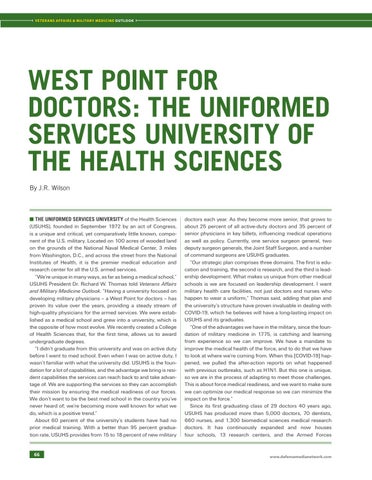V E TE R AN S AFFAI R S & M I LITARY M E D I CI N E O UTLO O K
WEST POINT FOR DOCTORS: THE UNIFORMED SERVICES UNIVERSITY OF THE HEALTH SCIENCES By J.R. Wilson
n THE UNIFORMED SERVICES UNIVERSITY of the Health Sciences (USUHS), founded in September 1972 by an act of Congress, is a unique and critical, yet comparatively little known, component of the U.S. military. Located on 100 acres of wooded land on the grounds of the National Naval Medical Center, 3 miles from Washington, D.C., and across the street from the National Institutes of Health, it is the premier medical education and research center for all the U.S. armed services. “We’re unique in many ways, as far as being a medical school,” USUHS President Dr. Richard W. Thomas told Veterans Affairs and Military Medicine Outlook. “Having a university focused on developing military physicians – a West Point for doctors – has proven its value over the years, providing a steady stream of high-quality physicians for the armed services. We were established as a medical school and grew into a university, which is the opposite of how most evolve. We recently created a College of Health Sciences that, for the first time, allows us to award undergraduate degrees. “I didn’t graduate from this university and was on active duty before I went to med school. Even when I was on active duty, I wasn’t familiar with what the university did. USUHS is the foundation for a lot of capabilities, and the advantage we bring is resident capabilities the services can reach back to and take advantage of. We are supporting the services so they can accomplish their mission by ensuring the medical readiness of our forces. We don’t want to be the best med school in the country you’ve never heard of; we’re becoming more well known for what we do, which is a positive trend.” About 60 percent of the university’s students have had no prior medical training. With a better than 95 percent graduation rate, USUHS provides from 15 to 18 percent of new military
66
doctors each year. As they become more senior, that grows to about 25 percent of all active-duty doctors and 35 percent of senior physicians in key billets, influencing medical operations as well as policy. Currently, one service surgeon general, two deputy surgeon generals, the Joint Staff Surgeon, and a number of command surgeons are USUHS graduates. “Our strategic plan comprises three domains. The first is education and training, the second is research, and the third is leadership development. What makes us unique from other medical schools is we are focused on leadership development. I want military health care facilities, not just doctors and nurses who happen to wear a uniform,” Thomas said, adding that plan and the university’s structure have proven invaluable in dealing with COVID-19, which he believes will have a long-lasting impact on USUHS and its graduates. “One of the advantages we have in the military, since the foundation of military medicine in 1775, is catching and learning from experience so we can improve. We have a mandate to improve the medical health of the force, and to do that we have to look at where we’re coming from. When this [COVID-19] happened, we pulled the after-action reports on what happened with previous outbreaks, such as H1N1. But this one is unique, so we are in the process of adapting to meet those challenges. This is about force medical readiness, and we want to make sure we can optimize our medical response so we can minimize the impact on the force.” Since its first graduating class of 29 doctors 40 years ago, USUHS has produced more than 5,000 doctors, 70 dentists, 660 nurses, and 1,300 biomedical sciences medical research doctors. It has continuously expanded and now houses four schools, 13 research centers, and the Armed Forces
www.defensemedianetwork.com













